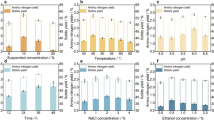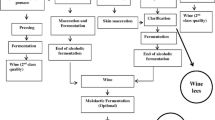Abstract
The aim of this study was to obtain preparations of sedimented wine yeast, which is an unutilised waste from the production of fruit wines in Poland. Yeast extracts, cell wall preparations and purified cell wall preparations were obtained as a result of complete yeast cells fractionation using initial phase of spontaneous autolysis and performed with various process promoters, such as NaCl, glucose, ethanol, acetic acid and lactic acid at different concentrations and in different combinations. The influence of applied autolysis promotors on protein recovery from yeast extracts and protein content in cell wall preparations was assessed. As an important property of yeasts cell wall preparation the influence of alkaline isolation and purification with acetic on the β-glucan content in cell wall were determined. The ability of yeast preparations to bind fat and water was also assessed. Sedimented wine yeast was characterised by low sensitivity to the autolysis process, as from 100 g of dry yeast, depending on the autolysis promoter used, 6.6–10.5 g of protein was recovered. The highest β-glucan content—35.0% in dry matter was assayed in purified cell wall preparation of sedimented wine yeast obtained after autolysis with 0.5% NaCl added to the autolysing mixture. The preparation’s water-binding and fat-binding capacities amounted to 304.8 and 82.9% respectively. Further research in applications obtained yeast products from new raw material (sedimented wine yeast) in food and feed industries must be investigated.






Similar content being viewed by others
References
Sahoo, P., Mukherjee, S.: Effect of dietary beta-glucan on immune responses and disease resistance of healthy and aflatoxin B1-induced immunocomprised rohu (Labeo rohita Hamilton). Fish Shelfish Immunol. 11, 683–695 (2001)
Thanardkit, P., Khunrae, P., Suphantharika, M., Verduyn, C.: Glucan from spent brewer’s yeast: preparation, analysis and use as a potential immunostimulant in shrimp feed. World J. Microbiol. Biotechnol. 18, 527–539 (2002)
Davis, M.E., Maxwell, C.V., Erf, G.F., Brown, D.C., Wistuba, T.J.: Dietary supplementation with phosphorylated mannans improves growth response and modulates immune function of weanling pigs. J. Anim. Sci. 82, 1882–1891 (2004)
Zduńczyk, Z., Juśkiewicz, J., Jankowski, J., Biedrzycka, E., Konwicki, A.: Metabolic response of the gastrointestinal tract of turkeys to diets with different levels of mannan-oligisaccharide. Poult. Sci. 84, 903–909 (2005)
Selvaraj, V., Sampath, K., Sekar, V.: Adjuvant and immunostimulatory effects of beta-glucan administration with lipopolysaccharide survival and some immune parameters in carp challenged with Aeromonas hydrophila. Vet. Immunnol. Immunopathol. 114, 15–24 (2006)
Li, J., Li, D.F., Xing, J.J., Cheng, Z.B., Lai, C.H.: Effect of β-glucan extracted from Saccharomyces cerevisiae on growth performance, and immunological and somatotropic responses of pigs challenged with Escherichia coli lipopolisaccharide. J. Anim. Sci. 84, 2374–2381 (2006)
Eicher, S., McKee, C., Carroll, J., Pajor, E.: Supplemental vitamin C and yeast wall cell beta-glucan as growth enhancers in newborn pigs and as immmunomodulators after an endotoxin challenge after weaning. J Anim Sci. 84, 2352–2360 (2006)
Waszkiewicz-Robak, B., Bartnikowski, B.: Effects of spent brewer’s yeast and biological β-glucans on selected parameters of lipid metabolism in blood and liver in rats. J.Anim. Feed Sci. 18, 699–708 (2009)
Solis de los Santos, F., Donoghue, A.M., Farnell, M.B., Huff, G.R., Huff, W.E., Donoghue, D.J.: Gastrointestinal maturation is accelerated in turkey poults supplementation with a mannanoligosaccharide yeast extract (Alphamune). Poult. Sci. 86, 921–930 (2007)
Wójcik, R.: The effect of Lieber Beta-S on selected parameters of immunity in calves. Acta. Vet. Brno. 83, 113–118 (2014)
Wójcik, R.: Effect of Biolex-MB40 on phagocytic activity and oxidative metabolism of peripheral blood granulocytes and monocytes in lambs. Pol. J. Vet. Sci. 17, 281–291 (2014)
Baurhoo, B., Goldflus, F., Zhao, X.: Purified cell wall of Saccharomyces cerevisiae increased protection against intestinal pathogens in broiler chickens. Int. J. Poult. Sci. 8, 133–137 (2009)
Thornton, J.: Brewer’s yeast extract: a survey of the type available to the food processor. Int. Food Ingredients. 2, 40–43 (1993)
Bednarski, W., Tomasik, J., Chylińska, D.: The yield of extraction and properties of mannoproteins from spent beer yeast. Pol. J. Food Sci. 49, 49–55 (1999)
Sombutyanuchit, P., Suphantharika, M., Verduyn, C.: Preparation of 5′ GMP-rich yeast extracts from spent brewer’s yeast. World J. Microbiol. Biotechnol. 17, 163–168 (2001)
Chae, H., Joo, H., In, M.J.: Utylization of brewer’s yeast cells for the production of food-grade yeast extract. Part 1: effects of different enzymatic treatments on solid and protein recovery and flavor characteristics. Bioresour. Technol. 76, 253–258 (2001)
Thammakiti, S., Suphantharika, M., Phaesuwan, T., Verduyn, C.: Preparation of spent brewer’s yeasts c for potential application in food industry. Int. J. Food Sci. Technol. 39, 21–29 (2004)
Worrasinchai, S., Suphantharika, M., Pinjai, S., Jamonong, P.: B-glucan prepared from spent brewer’s yeast as fat replacer in mayonnaise. Food Hydrocol. 20, 68–78 (2006)
Tangüler, H., Erten, H.: Utilisation of spent brewer’s yeast for yeast extract production by autolysis: the effect of temperature. Food Bioprod. Process. 86, 317–321 (2008)
Piotrowska, A., Waszkiewicz-Robak, B., Świderski, F.: Possibility of beta-glucan from spent brewer’s yeast addition to yoghurts. Pol. J. Food Nutr. Sci. 59, 299–302 (2009)
Kováčová, M., Dodok, L., Žofajová, l., Mikuš, L.: Preparation and characteristic of β-glucan concentrate from brewer’s yeast as additive substance in foods. Potravinarstvo. 7(1), 7–11 (2013)
Podpora, B., Świderski, F., Piotrowska, A., Rakowska, R.: Spent brewer’s yeast autolysates as new and valuable component of functional food and dietary supplements. J. Food Process. Technol. (2016). doi:10.4172/2157-7110.1000526
Nerantzis, E.T., Tataridis, P.: Integrated enology: utilization of winery by-products into high added value products. e-JST. 1(3), 79–89 (2006)
Pérez-Serradilla, J.A., Luque de Castro, M.D.: Role of less in wine production: a review. Food Chem. 111, 447–456 (2008)
Varelas, V., Tataridis, P., Liouni, M., Nerantzis, E.T.: Valorization of winery spent yeast waste biomass as a new source for production of B-glucan. Waste Biomass Valor. (2016). doi:10.1007/s12649-016-9530-4
Braga, F.G., Lencant e Silva, F.A., Alves, A.: Recovery of winery by-products in the Douro demarcated region: production of calcium tartare and grape pigments. Am. J. Enol. Viticult. 53, 41–45 (2002)
Devesa-Rey, R., Vecino, X., Varela-Alende, J.L., Barral, M.T., Cruz, J.M., Moldes, A.B.: Valorization of winery waste vs. the costs of not recycling. Waste Manage. (Oxford). 31, 2327–2335 (2011)
Cameron, D.R., Cooper, D.G., Neufeld, R.J.: The mannoprotein of Saccharomyces cerevisiae as an effective bioemulsifier. Appl. Environ. Microbiol. 54, 1420–1425 (1988)
Pogorzelski, E., Laskowska, J., Czyżowska, A.: Degradation products of nucleic acids in wines fermented with dried autolysate of sedimented wine yeast. Pol. J. Food Nutr. Sci. 56, 177–181 (2006)
Pozo-Bayón, M.A., Andujar-Ortiz, I., Alcaide-Hidalgo, J.M., Martín-Álvarez, P.J., Moreno-Arribas, M.V.: Characterization of commercial inactive dry yeast preparations for enological use based on their ability to release soluble compounds and their behavior toward aroma compounds in model wines. J. Agric. Food Chem. 57(22), 10784–10792 (2009)
Moine-Ledoux, V., Dubourdieu, D.: An invertase fragment responsible for improving the protein stability of dry white wines. J. Sci. Food Agric. 4, 537–543 (1999)
Lomolino, G., Curioni, A.: Protein haze formation in white wines: effect of Saccharomyces cerevisiae cell wall components prepared with different procedures. J. Agric. Food Chem. 55(21), 8737–8744 (2007)
AOAC: Official methods of analysis of the association of official analytical chemists. Arlington, Virginia (1995)
Schwenke, K.D., Prahl, L., Rauschal, E., Gwiazda, S., Dąbrowski, K., Rutkowski, A.: Functional properties of plant proteins. Part 2. Selected physicochemical properties of native and denatured protein isolates from faba beans, soybeans, and sunflower seed. Food/Nahrung. 25(1), 59–69 (1981)
Stecka, K., Komorowska, A., Mrówka, E., Grzybowski, R.: Activation of the baker’s yeast autolysis. Pol. J. Food Nutr. Sci. 49, 227–234 (1999)
Kosmala, M., Kołodziejczyk, K.: Procyanidins in the most popular in Poland desert apple varieties. Żywność. Nauka. Technologia. Jakość. 2(47), 124–134 (2006)
Petravić-Tominac, v., Zechner-Krpan, V., Berković, K., Gaković, P., Herceg, Z., Srečec., S., Špoljarić, I.: Rheological properties, water-holding, and oil-binding cApacities of particulate beta-glucans, isolated from spent brower’s yeast by three different procedures. Food Technol. Biotechnol. 49(1), 55–64 (2011)
Author information
Authors and Affiliations
Corresponding author
Rights and permissions
About this article
Cite this article
Rozmierska, J., Stecka, K.M., Kotyrba, D. et al. Preparation of Sedimented Wine Yeast Derived Products for Potential Application in Food and Feed Industry. Waste Biomass Valor 10, 455–463 (2019). https://doi.org/10.1007/s12649-017-0068-x
Received:
Accepted:
Published:
Issue Date:
DOI: https://doi.org/10.1007/s12649-017-0068-x




